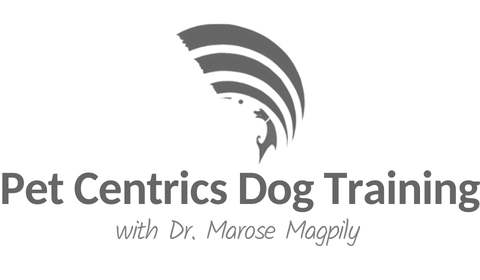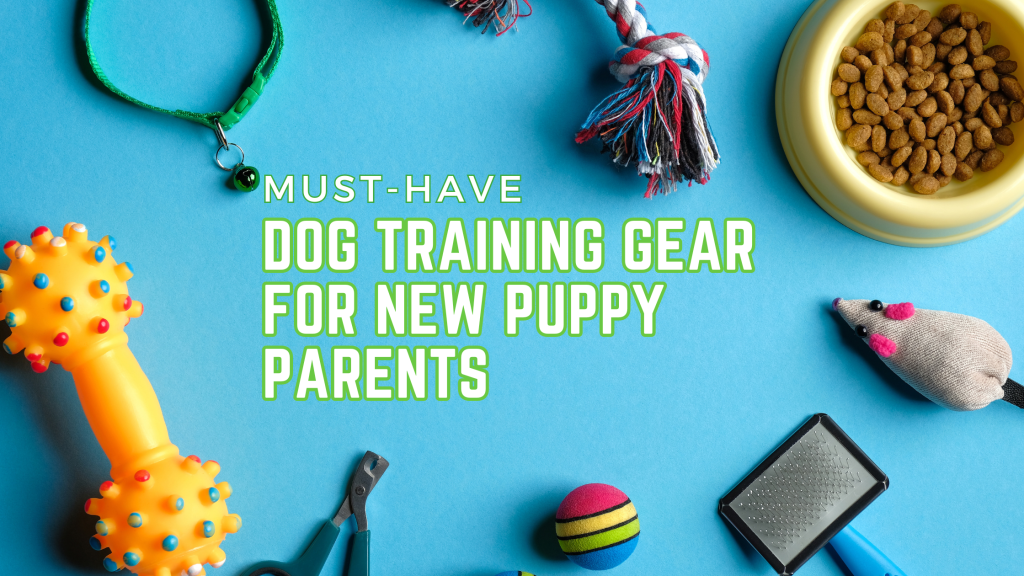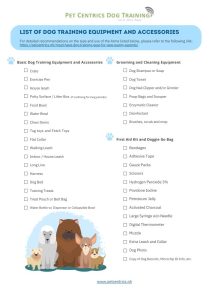To help you accomplish your puppy-rearing and training goals, I’ve prepared a list of items that I believe every dog owner should have at the ready. You won’t be needing all of the items right away since some of them will be important in different stages of your puppy’s life but it’s good to be prepared.
The use of each piece of equipment is discussed in greater detail below. Accessories and other important equipment and materials are also mentioned briefly towards the end of this post. Note that some of the items in my list should be introduced slowly, with proper conditioning so as not to have your puppy develop any negative associations with the equipment. Therefore, I recommend that you read through my notes about each item first to avoid using any equipment incorrectly and to learn how to properly introduce your puppy to it.
Your Puppy’s Crate
A crate is an invaluable tool in puppy-raising, both for management purposes and for training your puppy to do certain behaviors. Many of the solutions to problem behaviors such as potty accidents and chewing are dealt with more easily with the use of a crate. So it makes sense to immediately invest in a good crate as soon as you get your puppy.
Sizing The Crate
Your puppy’s crate should be appropriately sized, meaning that it should be large enough that the puppy can lie down at his full length, turn around, and sit and stand inside the crate without having to stoop too much. The crate should not be overly large. There should not be more space than necessary for the puppy to sleep in.
You may buy a crate sized for your puppy and then buy a larger one later on for his adult size. Or if you would rather buy a large adult-sized crate right away, you will have to reduce the accessible space within by filling it with a plastic box or container so that the puppy only has enough space for sleeping.
Most crate manufacturers provide sizing charts to help you determine what size is appropriate for your dog.
Choice of Material
The most common types of crates are either wire crates or hard plastic crates.
Wire Crates
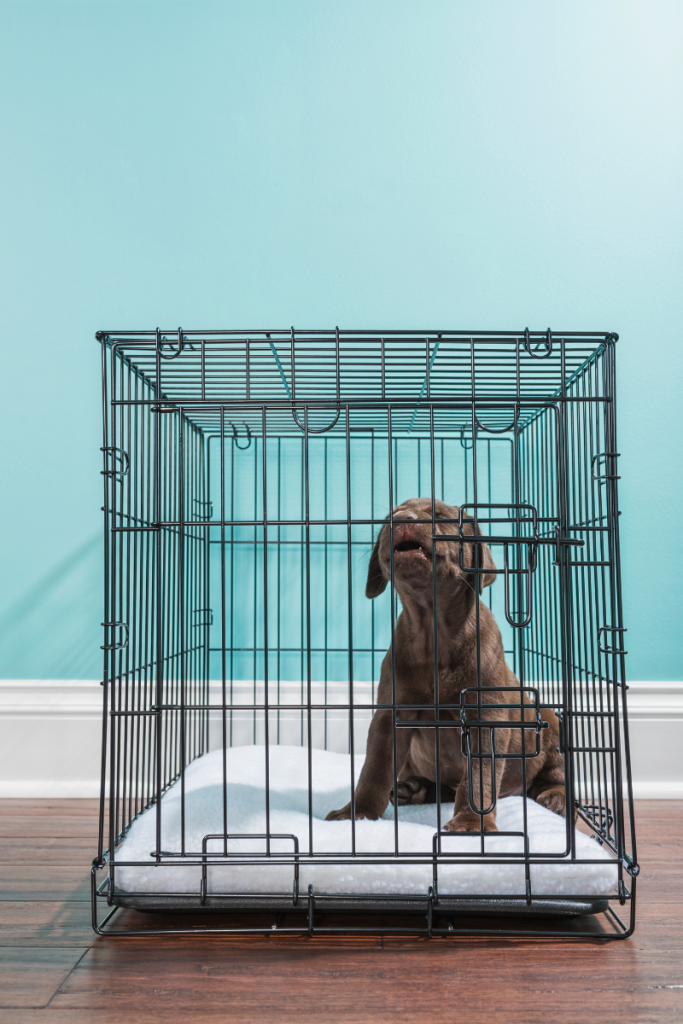
Wire crates offer greater ventilation, are usually collapsible and easily stored once folded. However, they can make a lot of rattling noise when a dog moves around inside them. This can be bothersome to you if your puppy’s crate is placed in the bedroom and the puppy starts to move around or shifts positions in the middle of the night while you are sleeping. The rattling wires can also frighten puppies that are sensitive to noises. If noise is not an issue with either you or your puppy, a wire crate can be considered.
If you are going to get a wire crate, get one with a flat bottom, not the one with a grill-type flooring. Grill-type flooring can be painful for a puppy to stand or lie on for long periods of time. If you’ve purchased a crate with this type of flooring, you may need to put a rubber mat or bed inside to make it more comfortable for your puppy.
Plastic Crates
Hard plastic crates are made of lighter material than wire crates. They aren’t collapsible like wire crates. Usually they come in two halves – a top and bottom – that can be clipped or screwed together.
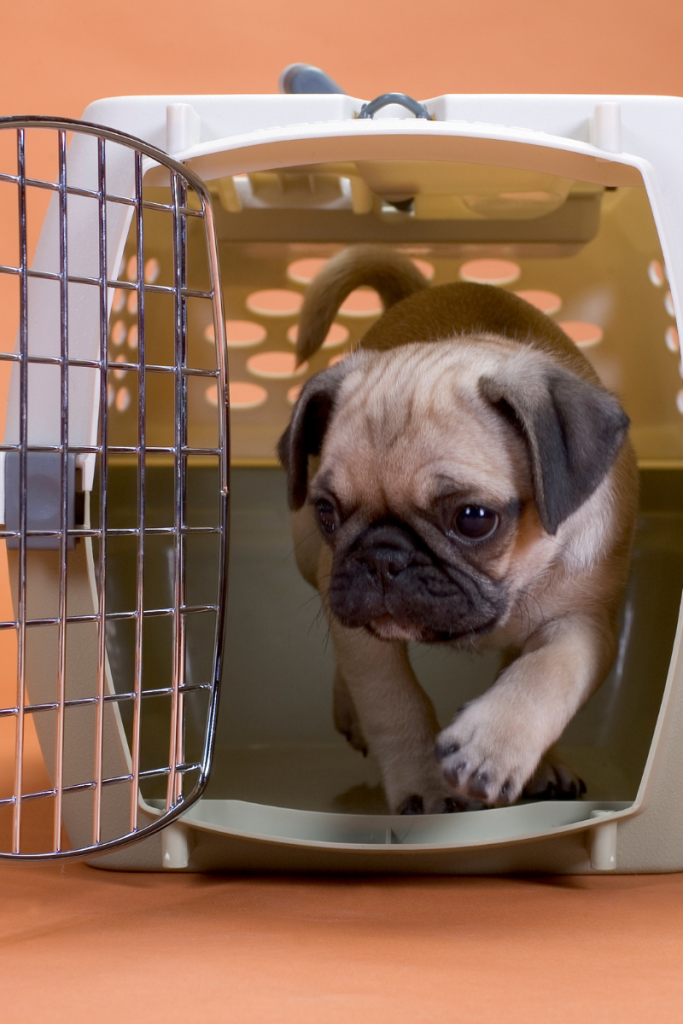
I personally prefer plastic crates over wire crates, especially for their use as a training tool, and because a plastic crate provides more of a covered den-like structure that the puppy can sleep in. Hard plastic crates are also acceptable for travel by airplanes provided they meet airline standards.
Exercise Pen
An exercise pen is useful for creating a play area or a long-term confinement area. Exercise pens usually come in 6 or 8 wire panels (each panel being about 2 – 2.5 feet wide) and in various heights appropriate to your puppy’s size to keep him contained in a small but comfortably-sized space. This area is a good way to manage the puppy when he gets too rambunctious or nippy.

Choice of Material
Exercise pens are generally made out of hard plastic or wire panels. When buying an exercise pen, test the assembly of the pen to see how well it stands up, and how easy it is to assemble or disassemble. Lighter pen materials such as plastic may be appropriate for small breed puppies. Heavier wire material should be used with large breed puppies, jumpers and chewers.
Size of the Pen
Make sure your puppy’s pen is appropriately sized for his height and weight because he may stand up with two paws on the panels. Most of the time, you will be supervising your puppy while in the pen, but if you are using it for long-term confinement, you have to make sure your puppy can’t climb or jump out.
Litter Box or Potty Surface
When keeping your un-potty-trained puppy inside the exercise pen during long-term periods of confinement, it is important to provide him with access to a litter box (or a potty surface), especially if no one will be around to take him to his outdoor potty area at regular intervals.
If using a litter box, make sure it is spacious enough that the puppy can comfortably stand inside it to do his business, with the sides being low enough that the puppy can climb in but not too low that litter material will easily spill out.
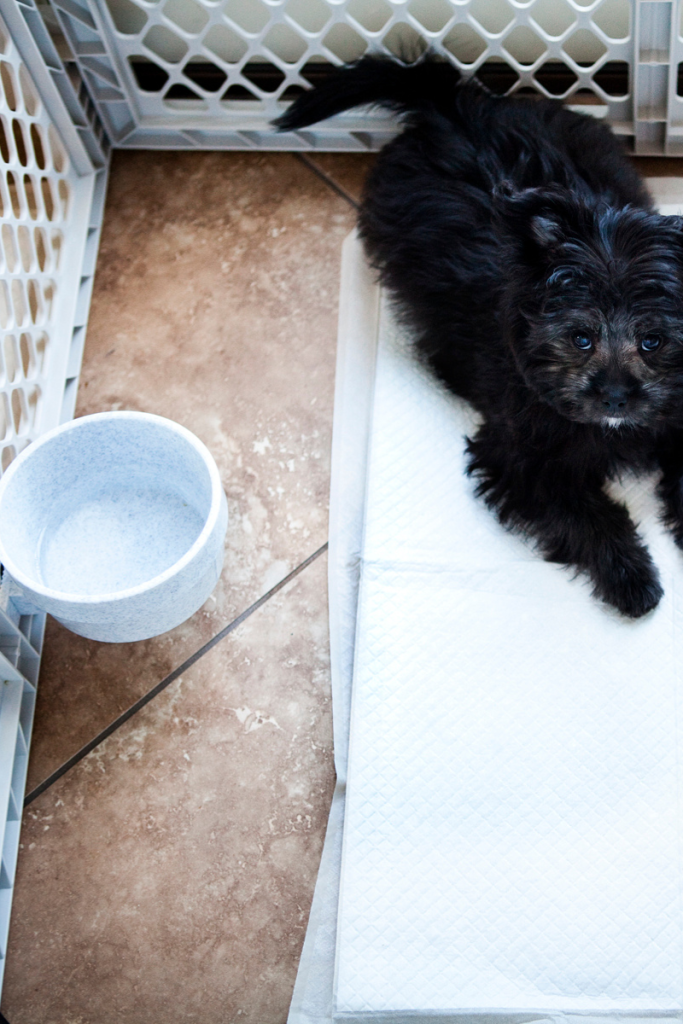
Choice of Potty Surface or Litter Material
Paper, puppy pads, artificial grass or commercially bought litter material specifically made for puppies are some of the options available for a choice of potty surface. Whichever option you choose, make sure it is safe for your puppy.
Some puppies will chew and eat litter material. If you have a puppy that does this, you may need to opt for a different way of potty training your puppy.
Chew Items
Puppies have a natural desire to work their jaws and to explore things with their mouth. So it’s a good idea to provide them with a variety of appropriate chew items to satisfy this need. Note that chew items are different from toys that are meant for interactive play between you an your puppy. Rope toys, plush toys, toys that are made of soft rubber and that have squeakers in them are not meant to be left with your puppy for him to chew on, destroy and potentially ingest, which could be very dangerous for your puppy.
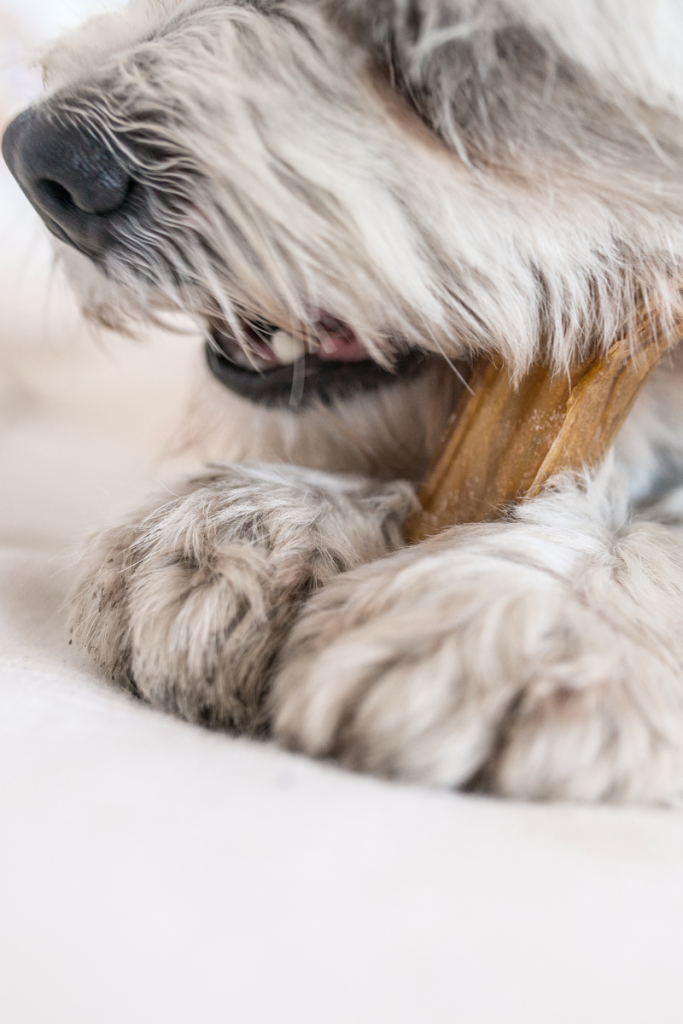
Appropriate chew items are commonly made out of of durable, hard rubber. I personally prefer the Kong chew toys especially the ones that are hollow and that you can fill with dog food or treats that the puppy will excavate out of the toy. Other options for chew toys are consumable dehydrated beef tendons, pig and cow ears and sterilized animal bones, antlers and hooves.
Whichever kind of chew items you buy for your puppy, make sure they are of a good quality, are not easily destroyed, and are appropriately-sized for your pup. Manufacturers usually make sizing charts available to accompany their products.
If you are not yet familiar with your puppy’s chewing habits, then it’s important that you supervise the puppy first while he/she is working on new chew items.
Toys
Teaching a puppy to play with appropriate toys is an one of the ways to divert puppy nipping. For instance, tug is a great game to help you teach your puppy impulse control and some important rules about what is appropriate to bite and when play should begin. Tug toys should be tough enough that they don’t fall apart too easily, but also soft enough that your puppy will actually like sinking his teeth into it. The softness and texture may vary according to what your puppy prefers, and you may need to buy 2 or 3 different toys for him so that you can trade and teach him to drop one item for another.
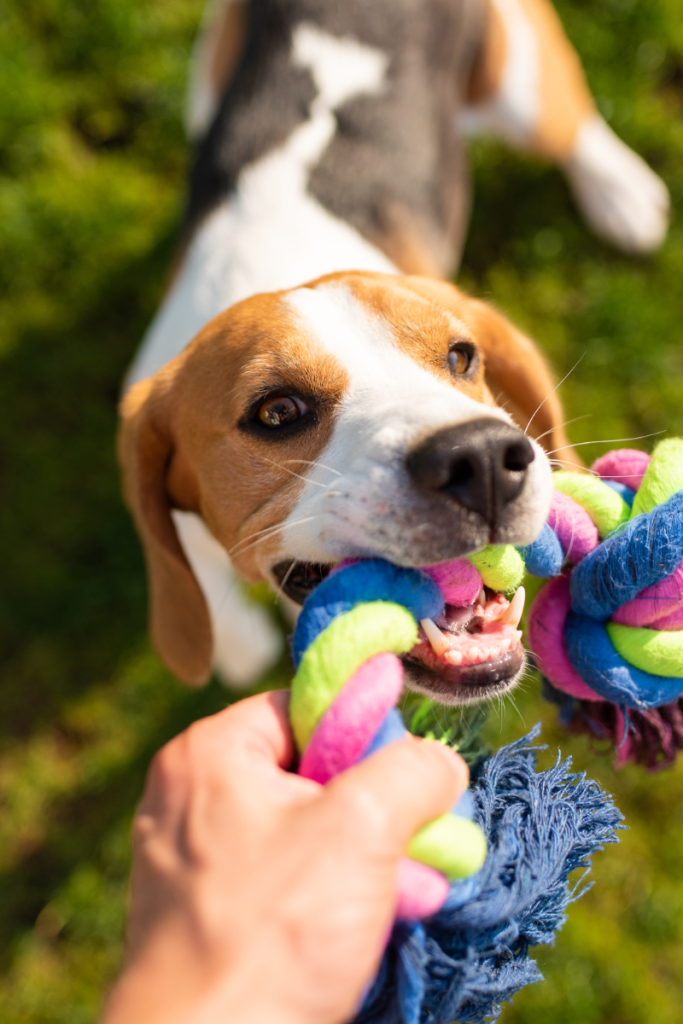
Fetch is another great game to play with your puppy and should be played with proper toys such as appropriately sized balls, frisbees and rubber fetch sticks. Don’t let your puppy fetch sticks or twigs as there is a danger that your puppy might injure himself when playing with these.
As previously mentioned, play toys are different from chew items which are meant for your puppy to work their teeth on. Never leave a toy with an unsupervised dog especially if your know your dog is likely to destroy and possibly swallow the parts. When you are done playing, put toys away and out of reach of your dog. This will also help preserve the value of the toys for training purposes.
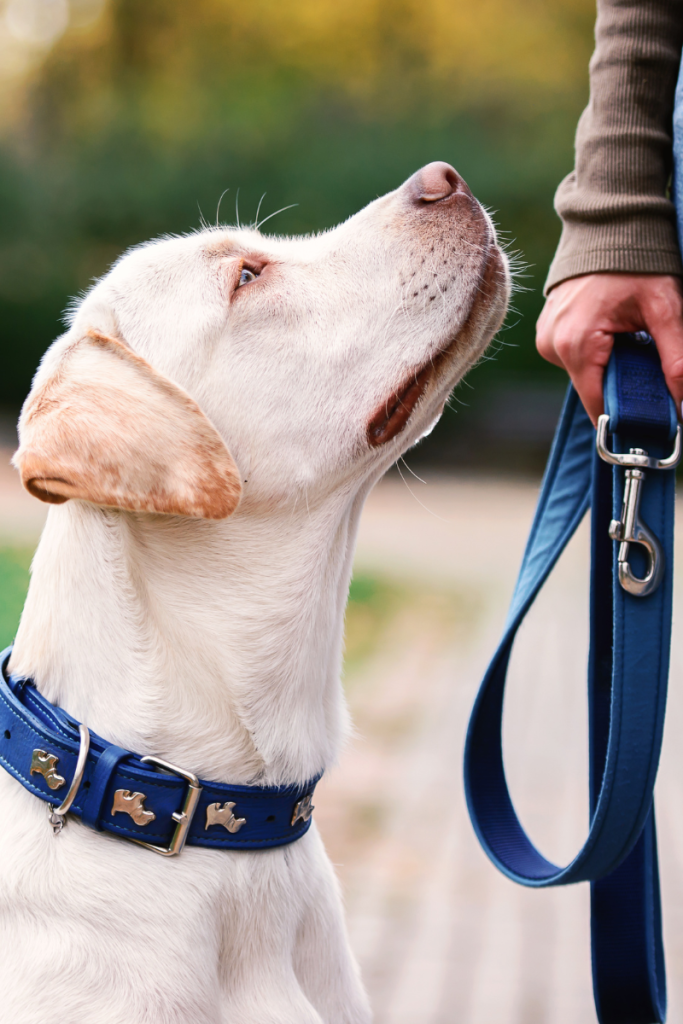
Collar
There are a variety of collars available for dogs, but for simplicity, we will only be using a flat collar on your puppy. Flat collars do not tighten even when there is tension on the leash.
Proper fitting
Buy a collar that is just right for your puppy’s current size. To ensure that the collar is properly fitted, insert two fingers under the collar while the dog is wearing it. Your fingers should slide in snug without there being too much space between the neck and collar. A loose collar can be just as dangerous as an overly tight one. If your collar is too loose your puppy will likely slip out of it or catch the collar in his mouth which may cause him to panic, and which may result in your puppy getting injured. Leashes attached to loose collars can also cause the attachment ring and leash clip to slide down under the dog’s neck causing any length of leash to hang close to the floor and trip up a dog’s legs.
Choice of Material
The collar can be made out of either nylon or leather. The buckle of the collar is either made out of plastic or metal. Choice of material depends on your personal preference. If you will be attaching an identification tag to your dog’s collar, make sure it’s lightweight, not too large and not too jangly. The noise from a dog tag can be bothersome for some puppies, particularly for noise-sensitive dogs.
I do not recommend the use of choke chains and prong collars because these can potentially cause damage to your puppy’s trachea or windpipe when they tighten around your puppy’s neck.
Leash
For walks, for outdoor training and even for a few indoor training exercises, you will need to have your puppy on leash. Even dogs that are reliable off leash should be kept on leash in observance of proper dog owner etiquette, and leash laws or regulations that apply in your area.
Proper length, width and weight
Regular walking leash
The leash should be at least 1.5m in length and not too heavy. I prefer leashes that are no more than half an 2cm thick so that the dog does not feel the weight. You don’t need a heavy leash even for big dogs especially if you invest time in teaching a proper loose leash walk at a young age.
House Leash
If your puppy is sometimes overly energetic and tends to jump and play bite you, it may be a good idea to always have him on a house line or house leash that he can just drag along whenever he is outside of his crate or pen. This will allow you to immediately get control of your puppy without having to put hands on him, especially if physical contact tends to make him even more excited or if he fidgets and nips at your hands when you try to restrain him.
With the house leash on, whenever he becomes over-aroused, starts to play bite, starts to jump on you, or even if he humps you or some other family member, you can quickly pick up the leash and gain control of him. To keep him from nipping at you, with the leash in hand, straighten and extend your hand while simultaneously shortening the leash as needed to keep your puppy away from your body. Make sure your puppy is able to keep his four feet on the ground. There’s no need to choke, leash pop, or pull up on the leash. Just calmly remain in this position until your puppy settles down, then calmly praise him when he does. You may then choose to play a proper game with him, or if necessary guide him to his pen or crate where he can calm down further.
Long Line
I also recommend you buy a long line about 8-10m in length. This is used for recall training (come-when-called) and prevents the dog from running off but gives him enough range to explore at a distance away from you. A long line should only be used in wide open spaces and should be attached to your dog’s harness to prevent injury.
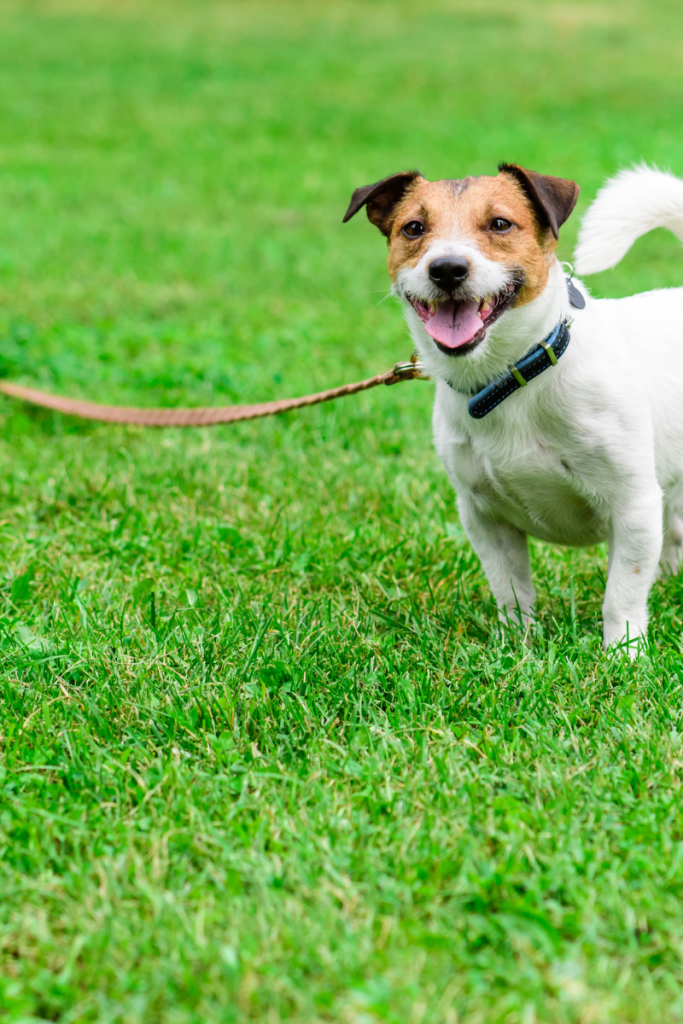
DO NOT buy a retractable leash for your puppy. They are pretty much useless for teaching good leash manners and can also be dangerous and harmful to your dog. I would only trust the most responsible and knowledgeable of dog owners, and those with dogs that are adequately trained, to use retractable leashes.
Material
Like the collar, your leash can be made out of nylon, leather. PVC-coated waterproof leashes are also now available. Chain is not advisable. It’s heavy, makes noise and can very easily hurt your hand if your dog suddenly pulls on it. I don’t recommend chain leads even if your puppy is a leash biter. There are ways to train a puppy out of biting the leash. If your puppy tends to bite on the leash, avoid expensive leashes for now.
The clip of the leash, that part that attaches to the collar should be lightweight but durable. Get a leash with a clip that is secure but that can also be easily unfastened and is not too heavy.
Training Treats
A variety of treats should be used as rewards, and should take into consideration your own puppy’s preferences in taste, and any health issues such as allergies that require special diets. Ready-made commercial treats already cut to appropriate sizes can be bought at pet stores for your convenience, but take note of the ingredients and make sure they are healthy and safe for your pet to consume.
Some important things to remember is that treats should offer no more than a quick taste of flavor, and should take no more than a few seconds to chew and swallow. If you are in the middle of a formal training session – practicing Sits, for example – you want to be able to proceed from one repetition of a behavior to the next in just a few seconds. For this reason also, don’t use treats that are sticky or that crumble as this may cause them to be difficult to handle and to drop out of your hand.
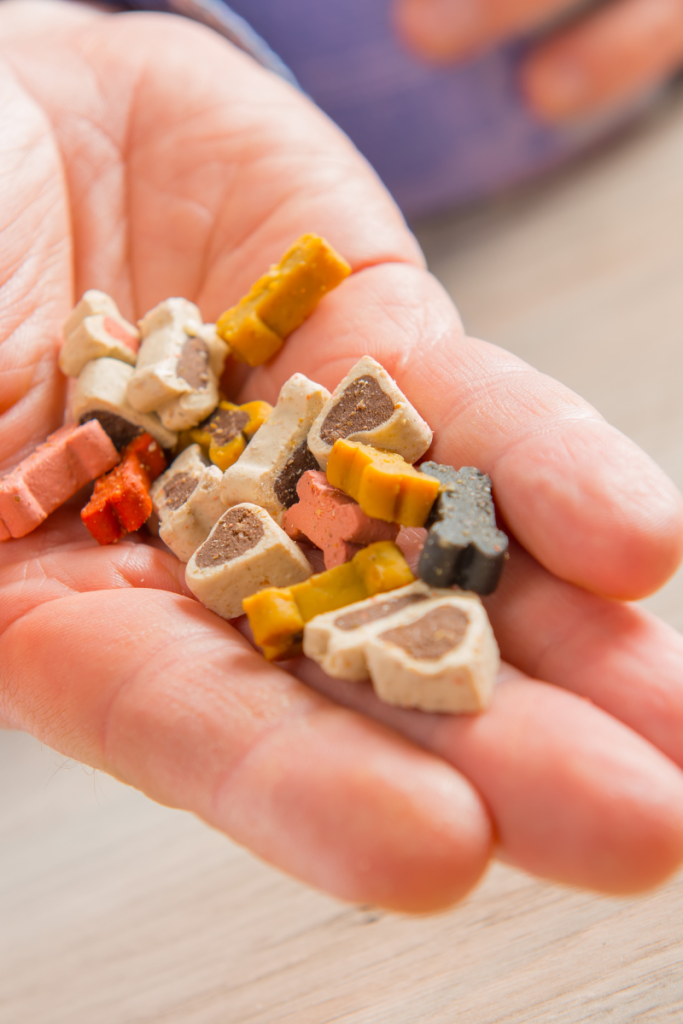
As you get to know your puppy, you’ll be able to identify his favorites and be able to rank treats from being low in value to high in value for your puppy. Some puppies will not be very discriminating in taste and will accept anything you give them as being high in value. Other puppies are much more picky and will look for certain flavors, scents or even specific textures in your treats. With such puppies, you will need to thoroughly experiment to find out what they like and what they don’t like.
Size of Treats
Treats should be sized appropriate to the size of your puppy or dog. Don’t make them too big that it will take your puppy more than a few seconds to consume it. This is important especially when you are doing many reps of a training exercise in a row. If your puppy spends too much time chewing on a treat, it breaks your dog’s focus and the flow of training. A half inch diameter is about right for most medium to large-breed puppies, while smaller puppies can be given treats that are a fourth of an inch in diameter.
Your treats should also be easy to dispense. Dry treats that are not sticky but also not crumbly are best.
Storing Your Treats
Your treats should be stored in various containers that will make it easy for you to access them. If your treats don’t spoil easily you can keep them in sealed containers in various parts of the house but out of reach of the puppy so that you can surprise the puppy with a few pieces whenever he is behaving well.
For exercises wherein you will be moving around, get a treat pouch or bait bag to keep the treats on your person, or you may choose to simply store them in your pockets. I don’t advise you keep them sealed in plastic bags that make noise as you reach for treats, since this sound may become like a cue for your puppy that treats are coming.
Other Equipment & Accessories
Water Bowl & Food Bowl
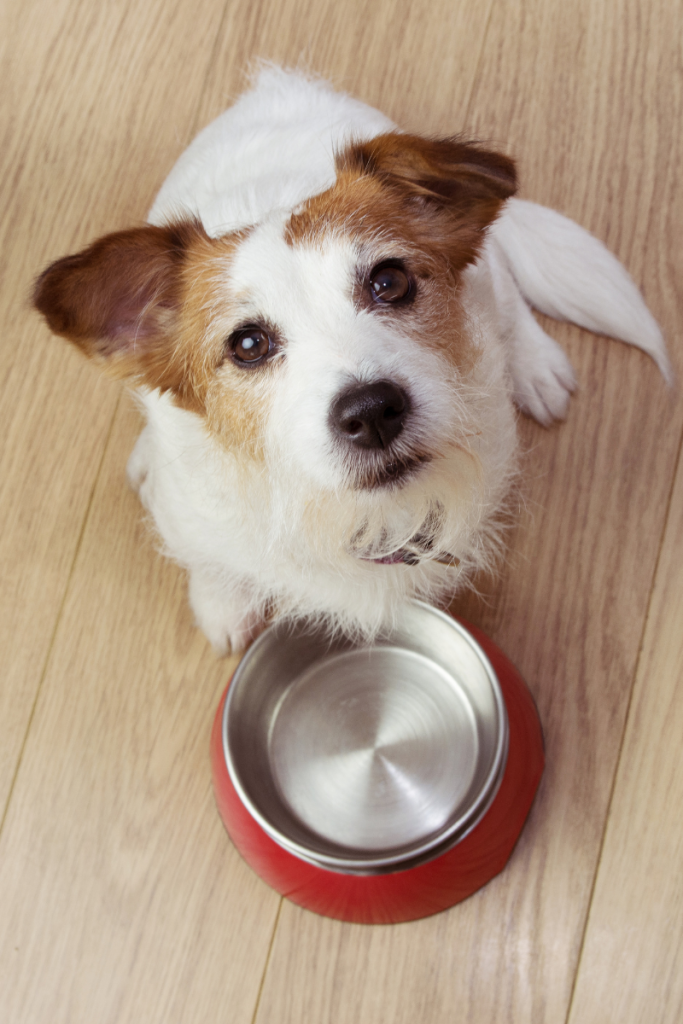
Stainless steel bowls for water and for feeding are recommended as they are the easiest to thoroughly clean. When serving meals, you can also replace the food bowl with meals stuffed into Kongs or similar chew items so as to slow down your puppy’s eating and to stimulate him mentally as well as physically during feeding time.
Harness
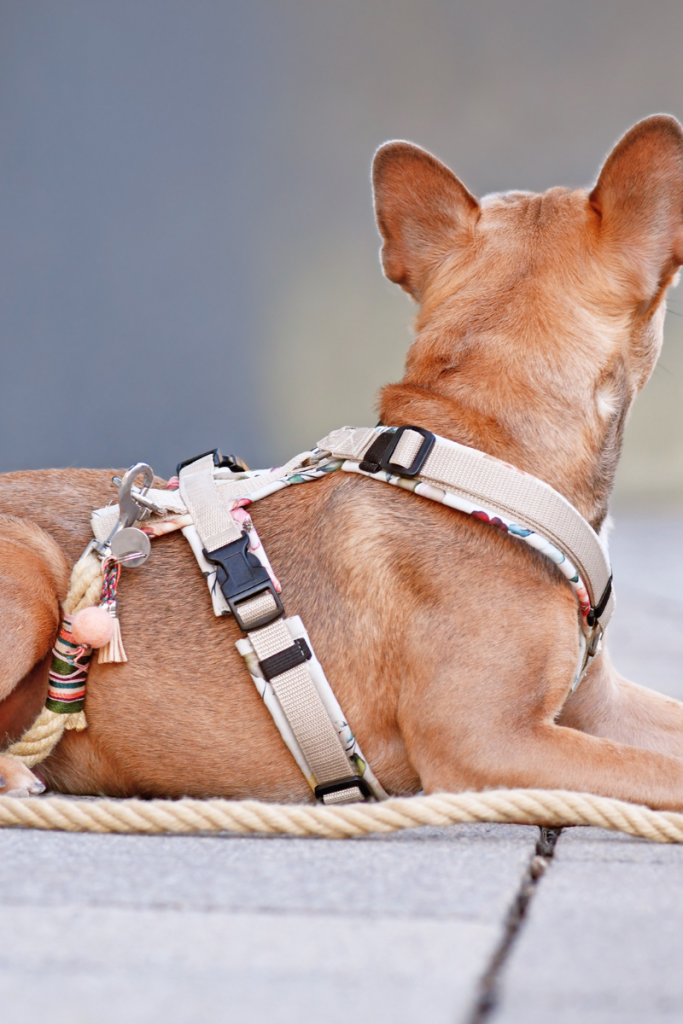
Recommended for use when the puppy is to be tethered and for training exercises done on a long line where the puppy is allowed to range far away from your side while outdoors.
While a harness can be a useful training tool, unfortunately, I have frequently observed that owners who opt for harnesses are more likely to allow pulling behavior because they are not afraid of their puppy or dog hurting their neck. This reinforces the behavior of pulling and in the long run makes it more difficult to train loose leash walking.
In other words, simply switching to this type of equipment should not be thought of as a solution to leash-pulling. If used incorrectly and without training it will only encourage the behavior of pulling even more.
When fitting a harness, get one that is adjustable and can be fitted snug against your dog’s body without too much chaffing. Avoid harnesses that have straps that limit the range of motion of the neck, back, shoulders and forelimbs as this may affect your dog’s natural stance and gait and cause mobility issues if used regularly.
Muzzle
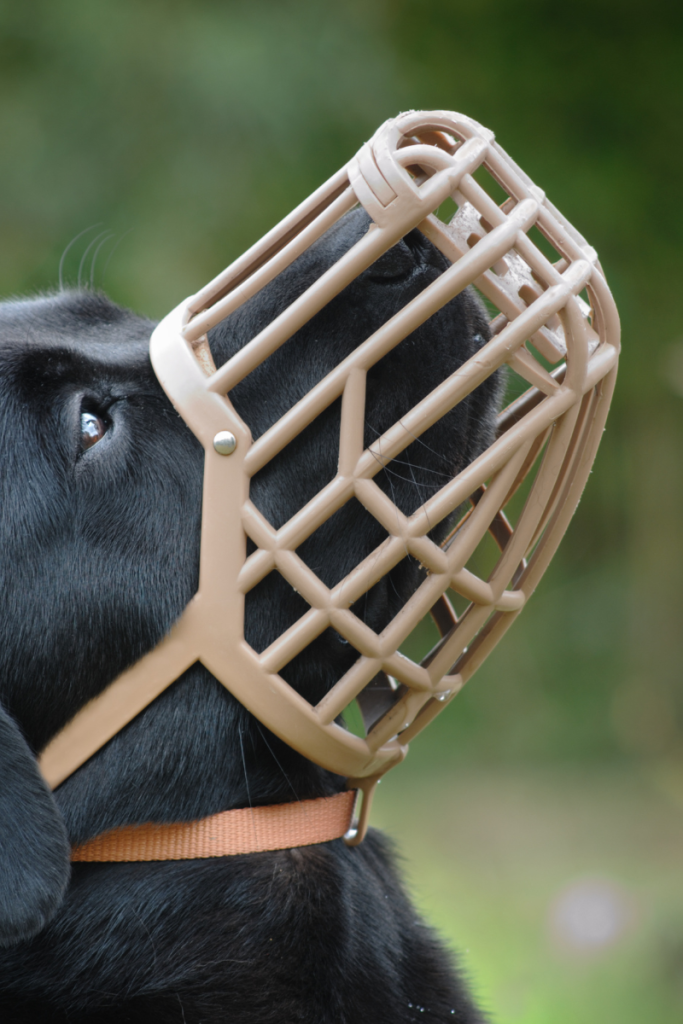
All dogs can benefit from being conditioned to wearing a muzzle, whether or not they are aggressive. A muzzle can be used in emergency situations, such as when you need to restrain the dog when he is injured. Even the nicest dogs may bite when in extreme pain. If the dog is already used to the muzzle, then there will be less of a struggle of putting the equipment on should the need arise.
A breathable, well-fitted, plastic or wire basket muzzle that allows adequate panting is recommended.
Dog Bed
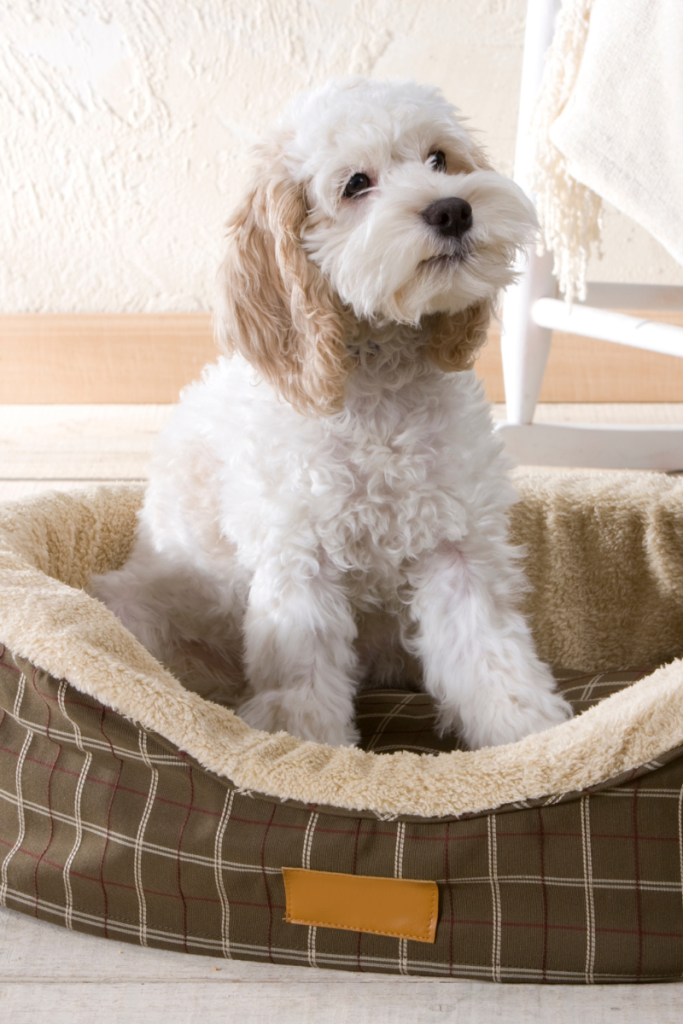
Dog beds can be used in place of crates to restrict the dog to one spot within the house. This behavior can be useful if you need your dog out of the way for some time, such as when visitors are over or when you are busy cleaning the house floors. Unlike crating the dog, sending the dog to his place on the bed is not as restrictive and the dog is still allowed to see the goings-on.
Going to the bed and staying on it are, of course, trained behaviors that need to be taught and practiced before they can be useful in real-life scenarios.
For size, your dog should be able to lie on the bed at his/her full body length. Make sure the bed is comfortable enough especially if you expect to train for long stays on it. A simple rubber mat, a padded platform are acceptable alternatives to commercially available dog beds.
Cleaning Materials
Poop Bags and Scooper
It is the responsibility of every dog owner to clean up after their own dog. Therefore, poop bags are essential to carry around with you at all times that your puppy is with you outdoors. A scooper helps to pick up poop, but a classic method for picking up poop without a scooper is to turn the plastic bag inside out, wear it like a glove, pick up the poop with your plastic-gloved hand, then turn the plastic over so that the poop ends up on the inside of the bag. Dispose of the poop-filled bag in the appropriate garbage bin. Remember to thoroughly wash your hands with soap and water, or disinfect with alcohol after scooping poop.
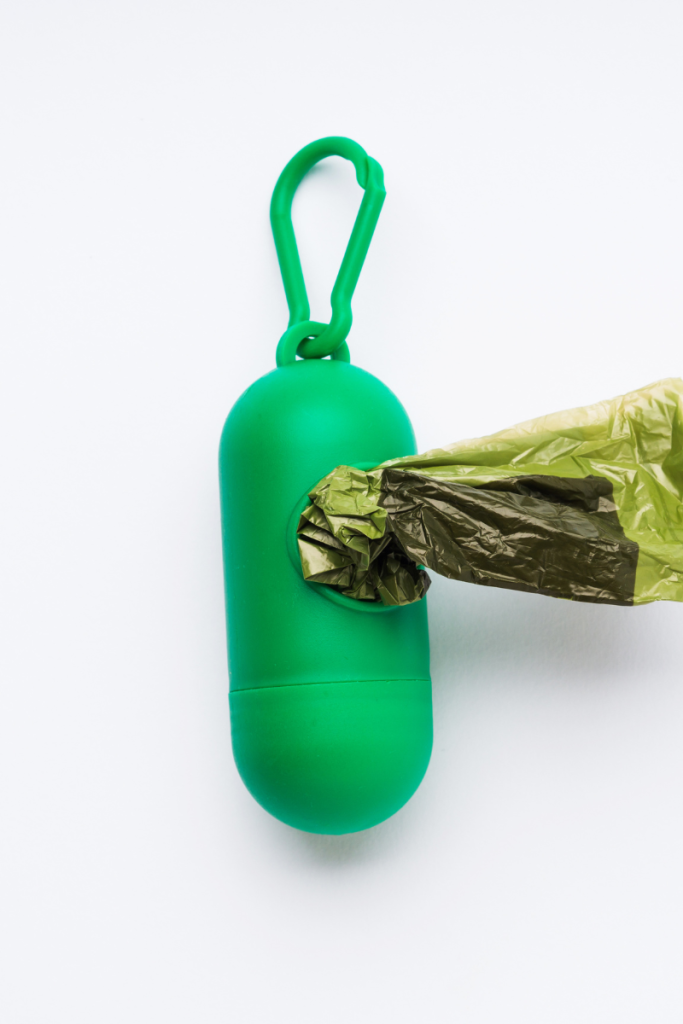
Enzymatic Cleaner
At home, cleaning soiled areas with regular household cleaners may not be enough to break down the scent particles that attract a dog to the same spot when he needs to relieve himself again. An enzymatic cleaner, however, should do the job.
Disinfectant
Dog feces and urine can be carriers of certain human diseases, so its important that you follow up with a good disinfectant after cleaning areas that your puppy may have soiled.
Brushes, scrubs and mop
Naturally, cleaning after your puppy will require certain tools. Prepare these beforehand so you can quickly clean up any messes before your puppy or other people living in the home accidentally step in them.
Grooming Materials
Dogs should be bathed once or twice a week using a good dog soap or shampoo. Use only warm water when bathing your puppy and towel dry or blow dry him immediately after. A variety of dog soaps and shampoos are available at pet stores but you should check if the ingredients are safe for your pet.
Special grooming equipment such as brushes or combs will be necessary depending on the kind of coat that your dog has. You may also purchase a pair of dog nail clippers to keep your dog’s nails trimmed.
First Aid Kit
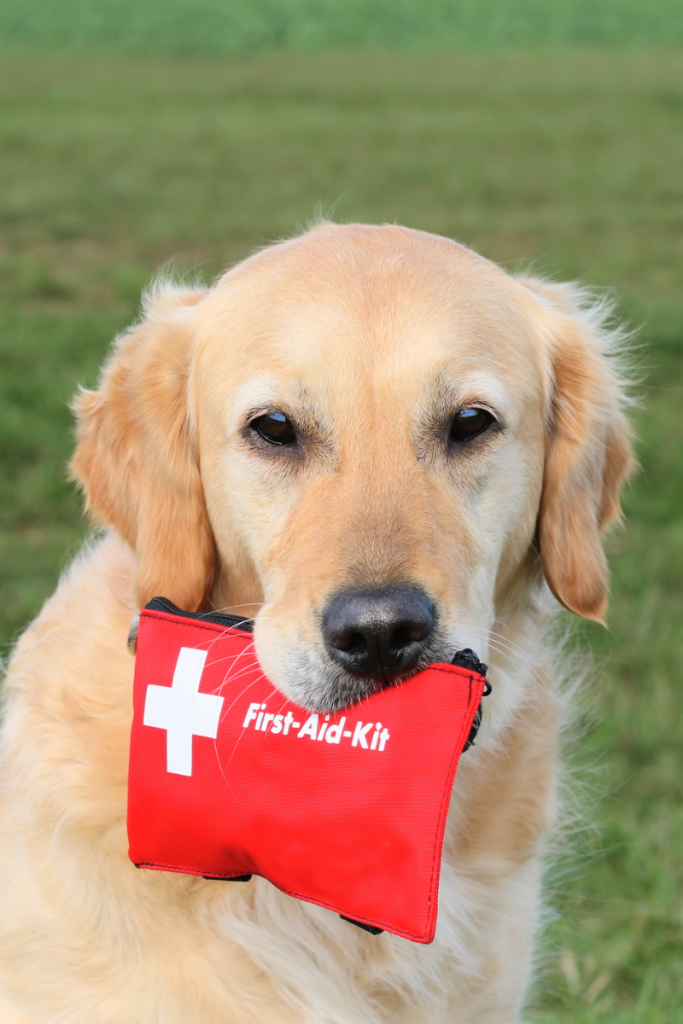
It’s good to be prepared with a first aid kit specifically stocked for pet emergencies. Some essential items to have in a pet first aid kit include:
- Bandages
- Adhesive Tape
- Gauze Packs
- Scissors
- Hydrogen Peroxide 3%
- Povidone Iodine
- Petroleum Jelly
- Activated Charcoal
- Large Syringe w/o Needle
- Digital Thermometer
- Muzzle
- Extra Leash and Collar
To help you remember the things you need to shop for on your next trip to the pet store, I have prepared a downloadable file of the list of dog training equipment I mentioned:
I hope you find this list and my suggestions useful. Next, we’ll talk about some preparations you’ll need to make in order to successfully execute the dog training plan that I have laid out for you and your puppy.
